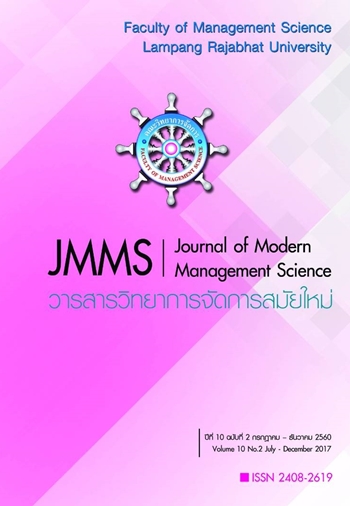Thainess and Local Wisdoms Integration through Food Supply Chain for Tourism Adding Value and Value Creation Approach
Main Article Content
Abstract
The research objectives aim to study the local ingredients in the research area to apply and add value to local food. Then, it has been analyzed the method to develop food supply chain into food tourism. Moreover, this research analyzed value added gastronomic tourism in Thainess. This study used qualitative research with in-depth interview and focus groups to find ways to integrate Thainess and local wisdom by studying local food supply chain to add value and value creation. Then, this research presented food as an example in designing the tourism experience. It purposes to access the local stories through human senses, also adds value in the tourist attraction and local Thai food as well. It enhances the value of local identity that can be expressed through food art. The research is based on the three pillars of the Thai way of life: nature, life, and art. It is a framework for research in case studies in three areas based on the criteria of capitalism and the level of tourism development, including Mueang District in Chiang Mai Province, Mueang District in SamutSongkhram Province, and Ban Rai Kong Khing community in Chiangmai Province. These research findings uncovered local raw materials for value added to local menus for tourists in each area. Through the process of searching for content, conceptualizing all concept and designing is a strategic approach to drive the Thainess and integrate tourism goods and services.
Article Details
The article must be considered and accepted for publication by the editorial board of the Faculty of Management Science, Lampang Rajabhat University. The articles have been reviewed by a peer (peer review) and the author must update according to the suggestion if available before publication. Articles that are not considered the editorial team will inform the results of the consideration but will not send the original to the author.
JMMS is the Faculty of Management Science journal, Lampang Rajabhat University. Jmms published both print and online editions. We allow the use of articles for academic use under the scope of copyright law.
References
Chen, Q. (2013). An Investigation of Food Tourism in Chongqing. International Journal of Management Cases, 15(4), 110-121.
Cleveland, D. A., Muller, N. M., Tranovich, A. C., Mazaroli, D. N., & Hinson, K. (2014). Local food Hubs for Alternative Food Systems : a Case Study from Santa Barbara County, California. Journal of Rural Studies, 35, 26-36.
Fredriksen, O.-H. (2008). Starving for food information. Food and Drink Technology, January 2008, 24.
Gaztelumendi, I. (2012). Global Trends in Food Tourism. UNWTO Global Report on Food Tourism, 4, 10-15.
Hall, C. M., Sharples, L., Mitchell, R., Macionis, N., & Cambourne, B. (2003). Food Tourism around the World: Development, Management and Markets. Oxford: Butterworth-Heinemann.
Harrington, R. J. (2005). Defining Gastronomic Identity: the Impact of Environment and Culture on Prevailing Components. Journal of Culinary Science and Technology, 4(2/3), 129-152.
Harrington, R. J. & Ottenbacher, M. C. (2010). Culinary Tourism: a Case Study of the Gastronomic Capital. Journal of Culinary Science and Technology, 8, 14-32.
Herrera, C. F., Herranz, J. B. & Arilla, J. P. (2012). Gastronomy’s Importance in the Development of Tourism Destinations in the World. UNWTO Global Report on Food Tourism, 4, 6-9.
Hjalager, A.-M. & Johansen, P. H. (2013). Food Tourism in Protected Areas – Sustainabiltiy for Producers, the Environment and Tourism?. Journal of Sustainable Tourism, 21(3), 417-433.
Holm, J., Pedersen, L. M. B. & Sorensen, S. (2013). Experiencing Organic Farms and Food by Regional Tourism Innovation. Acta Agriculturae Scandinavica, Section B – Soil and Plant Science, 63, 85-93.
Kesimoglu, A. (2015). A Reconceptualization of Gastronomy as Relational and Reflexive. Hospitality and Society, 5(1), 71-91.
Nilsson, J. H., Svard, A.-C., Widarsson, A. & Wirell, T. (2011). ‘Cittáslow’ Eco-gastronomic Heritage as a Tool for Destination Development. Current Issues in Tourism, 14(4), 373-386.
Richards, G. (2003). Gastronomy: An essential ingredient in tourism production and consumption? In Tourism and Gastronomy. London and New York: Routledge.
Santich, B. (1996). Looking for flavour. Kent Town: Wakefield Press.
Sofield, T. & Tamasese, E. (2011). Samoa: Tourism Led Poverty Reduction Programme. Apia, Samoa: International Trade Centre.
Telfer, D. J. & Wall, G. (2000). Strengthening Backward Economic Linkages: Local Food Purchasing by Three Indonesian Hotels. Tourism Geographies, 2(4), 421–447.
Vasileska, A. & Reckoska, G. (2010). Culinary Identity as Important Segment of Tourist Offer. Conference Proceedings of Tourism and Hospitality Management 2010 in Marcedonia, 1622-1628.
Wright, S. & McCrea, D. (Ed.). (2007). The Handbook of Organic and Fair Trade Food Marketing. Singapore: Blackwell Publishing.

